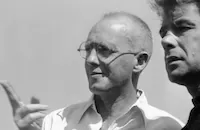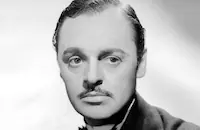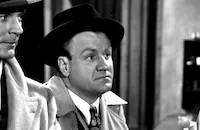Night Has a Thousand Eyes
Brief Synopsis
Cast & Crew
John Farrow
Edward G. Robinson
Gail Russell
John Lund
Virginia Bruce
William Demarest
Film Details
Technical Specs

Synopsis
On a starry night in Los Angeles, a wealthy young woman named Jean Courtland tries to jump in front of a moving train, but is saved by her boyfriend, oil geologist Elliott Carson. Later, at a restaurant, Elliott accuses John Triton, a middle-aged aquaintance of Jean, of trying to steal her fortune by foretelling her death. In his defense, John relates the following story: Twenty years earlier, while touring with a magic act with his fiancée Jenny and his best friend, Whitney Courtland, John discovers that he can actually foretell the future. Whitney uses John's ability to amass a small fortune for the trio through gambling and playing the stock market. While onstage one night, John foresees Jenny's death following the birth of their first child. Believing Jenny's marriage to Whitney will prevent her death, John advises Whitney to buy a piece of oil-filled Oklahoma land, and disappears. Back in the present, Jean tells Elliott that her mother died in childbirth, despite having avoided marriage to John. Returning to his story, John continues: Three months earlier, John, who moved to Bunker Hill in order to be closer to Jean and Whitney, has a vision of Whitney dying in an airplane crash and tells Jean, who has never met John. She warns her father too late, however, and he dies in an airplane crash in New Mexico. Although Elliott doubts the veracity of John's "visions," Jean, aware that her father and John were once best friends, goes to him in trust. Sadly, he tells her that she will die within the week, under the stars. Back in the present, as day breaks, Elliott takes Jean home to rest, then goes to the police, who tell him that Whitney's propeller shaft had been tampered with, which suggests that he was murdered. Meanwhile, Jean asks John to stay with her at the Courtland house, where he hopes to prevent her death. Also at the house are a group of oilmen who, before Whitney's death, were planning a merger with the Courtland oil interests, and are now in search of option papers. While in the house, John foresees his own death by gunfire, as well as details involving Jean's death: She is to die at eleven o'clock the following night, beneath the stars, following a sudden hot wind, the breaking of a vase, and a flower being crushed beneath a foot. She will also die near the feet of a lion after the words "There is no danger now" are spoken. On the night that John makes the predictions, someone tries to smother Jean with a pillow, and John is blamed. The following night, John is away from the house being interrogated by police psychologists. As Jean waits in terror for eleven o'clock to arrive, all of the details of John's vision begin to unfold. Minutes before eleven, the killer pushes the hands of the Courtland grandfather clock ahead so that when the hour chimes, Jean believes she has been spared and steps into the garden. As the killer speaks the words "There is no danger now," then begins to strangle Jean, John arrives and saves her, but is shot by the police, who think he is an accomplice to the murder. The assailant turns out to be one of the oilmen who opposed the Courtland merger. As John lies dead at his feet, Elliott, who now believes John sacrificed himself for Jean, retrieves a letter from John's pocket that foretells his own death during Jean's rescue.

Director

John Farrow
Cast

Edward G. Robinson

Gail Russell

John Lund

Virginia Bruce

William Demarest
Richard Webb

Jerome Cowan

Onslow Stevenson

John Alexander

Roman Bohnen
Luis Van Rooten
Henry Guttman
Mary Adams

Douglas Spencer
Philip Van Zandt
Jean King
Dorothy Abbott
Bob Stephenson
William Haade
Stuart Holmes
Jean Wong
Anna Tom
Weaver Levy
Wong Artarne
Jane Crowley
Joey Ray
Eleanore Vogel
Minerva Urecal
Antonio Filauri
Renee Randall
Marilyn Gray
Helen Chapman
Betty Hannon
Jerry James
Len Hendry

Lyle Latell
Jim Drum
Jimmie Dundee
Pat Flaherty
Billy Burt
Frank Hagney
James Davies
Harry Allen
Gladys Blake
Lester Dorr
Frances Morris
Harland Tucker
Regina Wallace
Violet Goulet
George Nokes
Audrey Saunders
Raymond Saunders
Russell Saunders
Walter Cook
John Sheehan
Albert Follet
Rae Patterson
Julia Faye

Margaret Field
Major Sam Harris
Marie Thomas
Edward Earle
Crew
Franz Bachelin
Endre Bohem
William H. Coleman
Sam Comer
Hans Dreier
Farciot Edouart
Gene Garvin
Hugo Grenzbach
Edith Head
Jonathan Latimer
Barré Lyndon
Ray Moyer
John F. Seitz
Eda Warren
Wally Westmore
Victor Young

Film Details
Technical Specs

Articles
Noir City 2008 Report, Part 4: Two Edward G. Robinson Films & TOMORROW IS ANOTHER DAY
Night Has a Thousand Eyes (1948) boasts one of noir's most evocative titles, and the first half of the film lives up to that poetic, dreamy promise. A woman (Gail Russell) appears to be afraid of the stars in the night as she runs to a train overpass and prepares to throw herself off. Saved at the last moment by her boyfriend (John Lund), the two return to a restaurant where Edward G. Robinson awaits them. How did Robinson know to send him to the train station, Lund asks? And Robinson tells them his story, revealed in flashback... He was a fake "mentalist" who toured around with his partners Jerome Cowan and Virginia Bruce putting on his act, until he started having actual visions which turned out to be true. Sometimes they were premonitions of which horse would win a race; sometimes they were of individuals' deaths and other disturbing things. Robinson found he had no control over this power. It struck randomly. He skipped out of town, leaving Bruce and Cowan to marry even though Robinson and Bruce had been involved. By leaving, Robinson hoped to prevent her death, which he foresaw. It didn't work. Russell is Bruce and Cowan's now-adult daughter, and Robinson has made it his mission to make sure that nothing will happen to her, now that a tragedy has also befallen her father Cowan.
This is all captivating stuff (more so on screen than on paper), delivered in flashbacks with Robinson's great voice describing the events and his feelings. The only problem is that halfway through the movie, when the flashbacks end and we continue in the present, there's a huge shift in tone and momentum. All the characters hole up in a mansion to wait and see if Robinson's premonition of Russell's death at 11pm on a certain night will take place. Robinson becomes under suspicion as a murderer and the movie loses his subjective presence - a big mistake. Instead, William Demarest dominates this portion as a cop, and his broad-comedy screen persona takes over, too. It's really disappointing, and the movie deteriorates into hokum.
Even Robinson thought so - literally. In his memoir All My Yesterdays, he devoted a mere eight words to the film, calling it "unadulterated hokum that I did for the money."
But there's still that mesmerizing first half! What stays in one's mind is how the story is actually about fate and doom - staples of film noir. Robinson is held captive by these mighty forces, and we are made to feel it strongly. The very night and stars are established to be ominous, a danger, which is about as pessimistic as you can get in a noir; as soon as it turns to night throughout this film, we automatically feel uneasy. Pretty amazing. Victor Young's beautiful score also does much to accentuate the mysteriousness of the story.
One of the pleasures of film noir (if "pleasure" is the right word!) is discovering how fatalism and doom can express themselves in so very many ways. In these movies, it's usually via an urban crime story in which we are aligned with a poor sap who gets sucked into a scheme which can only end one way, but there are many exceptions and variations out there, and one of them is The Red House (1947), a strange, dark story shot in the farm country of northern California. The movie's feeling of "noir" stems from a menacingly photographed rural landscape and, on a thematic level, Edward G. Robinson's psychological entrapment by his disturbing personal past.
At first we see the landscape as sunny and bucolic, and a teen romance story is set in motion involving Rory Calhoun, Lon McCallister, Allene Roberts, and a quite stunning 20-year-old Julie London (in one of her earliest screen appearances). McCallister goes to Roberts' farm after school to help around her parents' property, but we quickly discover that those parents (Edward G. Robinson and Judith Anderson) are in fact brother and sister, and Roberts is their foster daughter. The weirdness of that situation points to something ominous in their past. When McCallister declares he will take a shortcut home by walking through the "Ox Head woods," Robinson goes into a conniption, warning the boy not to go that way and to beware "the screams in the night" that he will hear there. Just as suddenly, a ferocious windstorm picks up, and the entire landscape is one very scary place. McCallister goes through the woods anyway, in a bravura sequence in which the darkness, wind, gnarled trees and wonderfully eerie Miklos Rozsa music all combine to create a feeling of intense dread and deep fear that everyone has felt at one time or another in their childhood.
Robinson will go to any length to keep people from trespassing in the Ox Head woods and venturing near the decrepit, old red house that can be found within. Why the woods and the red house are off limits and so scary is a question that the rest of the movie takes its time in revealing. (Too much time, to be honest.) Suffice it to say that old family demons arise after being hidden away for many years, and that Robinson's kindly father-like character turns out to mask something very sinister.
The Red House is atmospheric and superbly scored but also a bit too static, even with all the psychological turmoil going on. Perhaps it's the teen romance subplot, which isn't all that interesting. Or perhaps it's the directing of Delmer Daves, whom I've personally always found to be a stronger writer than director. (He does both here, having adapted the film from a novel.) I kept wishing that Jacques Tourneur had directed this picture, or that Val Lewton had produced it. Imagine what they could have done with this spooky material! A good film might have become great.
The cast features popular young actor Lon McCallister, who had quite a career going at this point, but Rory Calhoun makes a bigger impression. When he's in the frame, he really commands it. One final note about The Red House: it was made as an independent film, released by United Artists, which is why it's in the public domain and remains so hard to see in a good-quality print. (Here it was screened in a 16mm print loaned by UCLA.) Robinson and producer Sol Lesser, a former chief of RKO, set up a production company and then managed to raise the financing and a distribution deal on the strength of the talent involved. In his memoir, Robinson wrote simply, "It was a moody piece, got moody notices, but I think it made a few bucks."
Tomorrow is Another Day
A last-minute replacement for Sunday's promised show of The Clay Pigeon (1949) was Tomorrow is Another Day (1951), directed by Felix Feist. (Pigeon's print didn't show up.) The program notes describe the picture as being like "Gun Crazy scripted by Steinbeck," and there's something to that characterization.
Steve Cochran stars as a man released from jail after 18 years; since he was just 13 when he was sent in, he finds that the world has moved on without him, and he's lonely and vulnerable. Early scenes of Cochran poking around town, bewildered by a modern car's gadgets, ordering three pieces of different pies at once in a diner, and the like, are compelling. After being duped by a local reporter who wanted to secretly get a story of the freed murderer's first day out of prison, Cochran leaves town because he knows no one will hire him, and finds his way to New York, where he's never been before. He gets involved with taxi dancer Ruth Roman, and before we know it, there's a tussle in Roman's room involving a police officer, who is shot and later dies; Roman and Cochran go on the run, believing themselves hunted by the police, and they wind up in California to start a new life as farm workers.
It's a strange plot direction but allows for some beautifully scripted and played scenes with a fellow family of workers headed by Ray Teal and Lurene Tuttle, which is where the Steinbeck comparison comes in; through these scenes, we get a glimpse of Americana through the eyes of minimum-wage workers trying to make it honestly and provide for their families. Teal and Tuttle's struggle over their temptation to turn Cochran over to the police when they discover he is a fugitive is a sequence at once utterly believable and purely American. It's wonderfully acted by both, too.
Even though Tomorrow turns into a lovers-on-the-run movie (and a pretty good one at that, with one or two very suspenseful set pieces) its most penetrating "noir" feeling comes from the early scenes of Cochran unable to find work or a footing in life. The world is seen as a big, strange, unrelenting place, with no room for this man who only wants a fair shake. Adding to the unsettling, hopeless feeling is the fact that Cochran is like a boy in a man's body as a result of having grown up in prison. He has limited skills and no clue how to talk to or behave with women. It's a fascinating notion, but the movie is only able to hint at his virginal state so far, due to production code requirements.
by Jeremy Arnold

Noir City 2008 Report, Part 4: Two Edward G. Robinson Films & TOMORROW IS ANOTHER DAY
Quotes
Trivia
Notes
A pre-production announcement in Paramount News lists Joan Caulfield as the film's star, but she was later replaced by Gail Russell.














